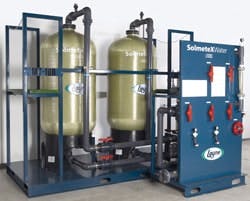Reducing Arsenic Levels
The Leicester Water Supply District is located in Worcester County, Mass., about an hour west of Boston. Like many American communities, Leicester’s population of more than 10,000 is entirely dependent on groundwater for its potable water supplies. And like many American communities, Leicester’s groundwater contains arsenic, a metal that occurs naturally in groundwater as both arsenite and arsenate. Arsenic may occur naturally, but it is a carcinogen, and the U.S. Environmental Protection Agency has established a maximum contaminant level (MCL) for arsenic in drinking water.
The arsenic treatment system for Paxton was tendered for public bid with the stipulation that there could be no onsite residuals created or requirements for waste to drain.
In April 2008, SolmeteX Water delivered two 100-gal-per-minute (gpm) adsorption arsenic treatment skids for the Paxton Well #3. These treatment skids are part of a family of pre-engineered systems that provide cost-effective arsenic removal for flow rates from 50 to 300 gal per minute (gpm). The Leicester arsenic treatment skids each have two 42- by 72-in. columns with 29 cu ft of ArsenX np media in lead/lag configuration. The pre-engineered concept provides simple and affordable toxin removal for the non-community and small municipal water treatment markets.
While the system has not yet been installed at the site, a pilot study was performed at the Paxton well from June until December 2005 with ArsenX np media . Approximately 3 liters of the media was placed in a 2-in.-diameter column to form a 59-in.-tall bed. Sample points were placed in the column to allow the arsenic breakthrough down the column to be followed.
The system was designed to have a 3-minute empty bed contact time. The pilot system ran for 24 hours per day, 7 days per week and did not need to be backwashed during the entire test. The only interruption was when the system was moved indoors in late fall to avoid any chance of the water freezing. At 100,000 bed volumes, the column still did not experience any measurable arsenic breakthrough using approved methods, and the pilot was deemed successful.
At the heart of the system is a media comprised of an arsenic selective hydrous iron oxide chemistry impregnated into a very durable polymer substrate. The media was developed to remove both arsenate and arsenite from water. The media’s macroporous substrate provides a large surface area that offers both rapid kinetics and high arsenic capacity. The system was ideally suited for the well because the substrate also means that no fines, backwash or routine maintenance are required.
